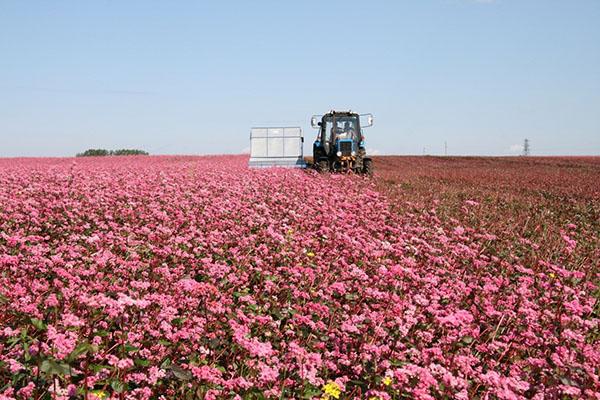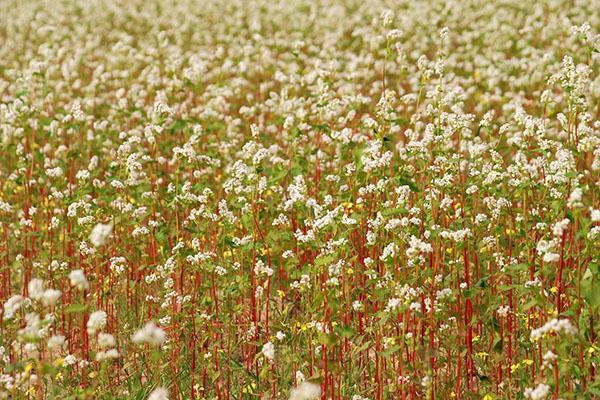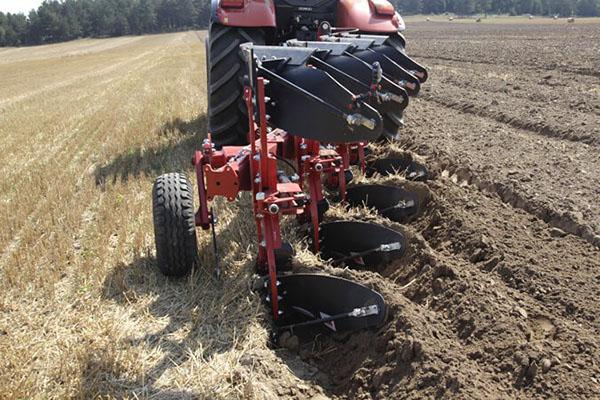Buckwheat cultivation technology from sowing to harvesting
 Herbaceous, grain and melliferous plant belongs to pseudo-grain. Modern technology of cultivation of buckwheat in Russia has made it possible to bring the country to the first place in the production of cereals. China ranks second with a large margin (almost 3 times less).
Herbaceous, grain and melliferous plant belongs to pseudo-grain. Modern technology of cultivation of buckwheat in Russia has made it possible to bring the country to the first place in the production of cereals. China ranks second with a large margin (almost 3 times less).
Buckwheat biology

Biological features of buckwheat:
- The leaves are alternate arrow-ovate or arrow-triangular in shape.
- The taproot serves as a water supply for the plant with lateral superficial processes to absorb nutrients from the upper soil layers.
- The flowers are dimorphic, bisexual, heterostyle, white or pink in color with a pronounced odor, appear in July. When buckwheat blooms, there are always a lot of bees on the plantation.
- The fruit is a triangular, matte nutlet, 4-6 mm long, 3-5 mm thick, light green in color.
- Ripening is very uneven - the lower ripe fruits may already crumble, and the top is still blooming.
Buckwheat is considered a late crop; harvesting in central Russia takes place since September.
Buckwheat cultivation technology - where to start
 Productivity largely depends on climatic conditions and soil. It should be light sandy loam with a neutral or slightly acidic reaction and normal moisture. Since the culture is late sowing, the main task in soil cultivation is its structuring and maximum moisture retention.
Productivity largely depends on climatic conditions and soil. It should be light sandy loam with a neutral or slightly acidic reaction and normal moisture. Since the culture is late sowing, the main task in soil cultivation is its structuring and maximum moisture retention.
Tillage includes:
- Winter plowing (conventional, improved or semi-steam) plowing.
- Harrowing in the spring.
- Pre-sowing cultivation (by 10 cm and by 5 cm) - depending on the germination of weeds.
In addition, the culture responds well to deep main processing (moldboard and moldboardless) up to 26-28 cm.
Fertilizers
 Proper fertilization significantly increases yields.
Proper fertilization significantly increases yields.
To form 100 kg of grain, plants are removed from the soil:
- 3-4 kg nitrogen;
- 3-5 kg of phosphorus;
- 6 kg of potassium.
In this case, phosphorus-potassium fertilizers are applied in autumn plowing or when sowing buckwheat, nitrogen fertilizers - in the spring during cultivation or as a top dressing during the budding period (60-70 kg of ammonium nitrate or urea per 1 ha). Nitrogen contributes to an increase in grain mass, improves its chemical composition and reduces hulliness. Nitrogen is not required for fertile chernozem.
Chlorine-containing fertilizers are applied exclusively in autumn, as the plants react to them negatively.
To improve the structure of the soil, cut straw, corn stalks and sunflowers are introduced. Manganese sulfate (100 g), zinc sulfate (50 g), boric acid (150 g) per ton of seeds are used as microelements.
Sowing

Research and many years of experience have proven that buckwheat should be sown after:
- beets;
- winter crops;
- corn;
- legumes;
- turnover of the layer of perennial grasses.
The technology of cultivation of buckwheat on the site of the dead spring and winter crops is allowed. Buckwheat should be sown when the soil warms up to 13-14 degrees.
Flowering time should not be during heavy rains or dry periods.
Often sowing is carried out in three stages, then the timing of sowing buckwheat is as follows:
- Early - carried out on weed-free lands when the threat of frost has passed.
- During mass germination of millet weed vegetation.
- In the early days of June, post-harvest sowing is possible.
Sowing in narrow (7 cm), ordinary (15 cm) on poor soil or in wide (45 cm) rows on fertile and more contaminated soils by methods. The rows are arranged in a north-south direction. Sowing is done with SZ-3.6, SZU-3.6, etc. seeders; for the wide-row method, a beet or vegetable seeder is used. The latest version of the buckwheat cultivation technology, together with the hilling of row spacings in the second cultivation and pre-harvest spraying with 10% ammonium nitrate, is very effective. At the same time, the quality of grain improves, it becomes possible to do without herbicides for buckwheat and harvesting by direct combining.
The seeding rate for buckwheat can vary widely.
| Region | Narrow row sowing | Wide row sowing |
| North-West, Central and Volgo-Vyatka | 90-100 kg / ha | 50-60 kg / ha |
| Central Black Earth, Volga Region, North Caucasus | 60-80 kg / ha | 45-55 kg / ha |
| Siberia, Far East | 70-80 kg / ha | 50-60 kg / ha |
Seeds are planted 5 cm in wet soil, 7 cm in dried soil and 4-6 cm in clay soil with early sowing.
Care

Plant care during cultivation is as follows:
- Simultaneously with sowing, the earth is rolled up.
- Before and after sprouting, they are harrowed with light, mesh or medium harrows in order to crush the soil crust and filamentous weeds.
- Seedlings are harrowed with 1-2 true leaves, wide rows of crops are harrowed twice: 6 cm when two true leaves appear and when buds are tied, 7 cm in dry weather, 10-11 cm - with high humidity.
 Herbicide spraying in spring has a positive effect on the destruction of annual dicotyledonous weeds. It is carried out a day or two before germination.
Herbicide spraying in spring has a positive effect on the destruction of annual dicotyledonous weeds. It is carried out a day or two before germination.
Pollination by bees is an important agricultural technique for increasing yields. Bee hives in the field are exposed at the rate of 2-3 bee colonies per hectare.
Harvest
 Buckwheat harvesting depends on the formation, filling and ripening of the fruits, which is greatly extended in terms of time. Separate collection begins when 75% of the nuts on the plant are ripe. Headers are used ZhVS-6, ZhVN-6 and others. The rolls are placed perpendicular to the sowing rows. The stubble height should be at least 14 cm. In a few days, the plants dry out in the rolls, the fruits ripen. When their moisture content is 15-17%, they begin to process buckwheat.
Buckwheat harvesting depends on the formation, filling and ripening of the fruits, which is greatly extended in terms of time. Separate collection begins when 75% of the nuts on the plant are ripe. Headers are used ZhVS-6, ZhVN-6 and others. The rolls are placed perpendicular to the sowing rows. The stubble height should be at least 14 cm. In a few days, the plants dry out in the rolls, the fruits ripen. When their moisture content is 15-17%, they begin to process buckwheat.
They are picked up and threshed by a grain harvester with a canvas-slat pick-up at 600-800 rpm. You can also harvest the crop directly with a combine after the first freeze.